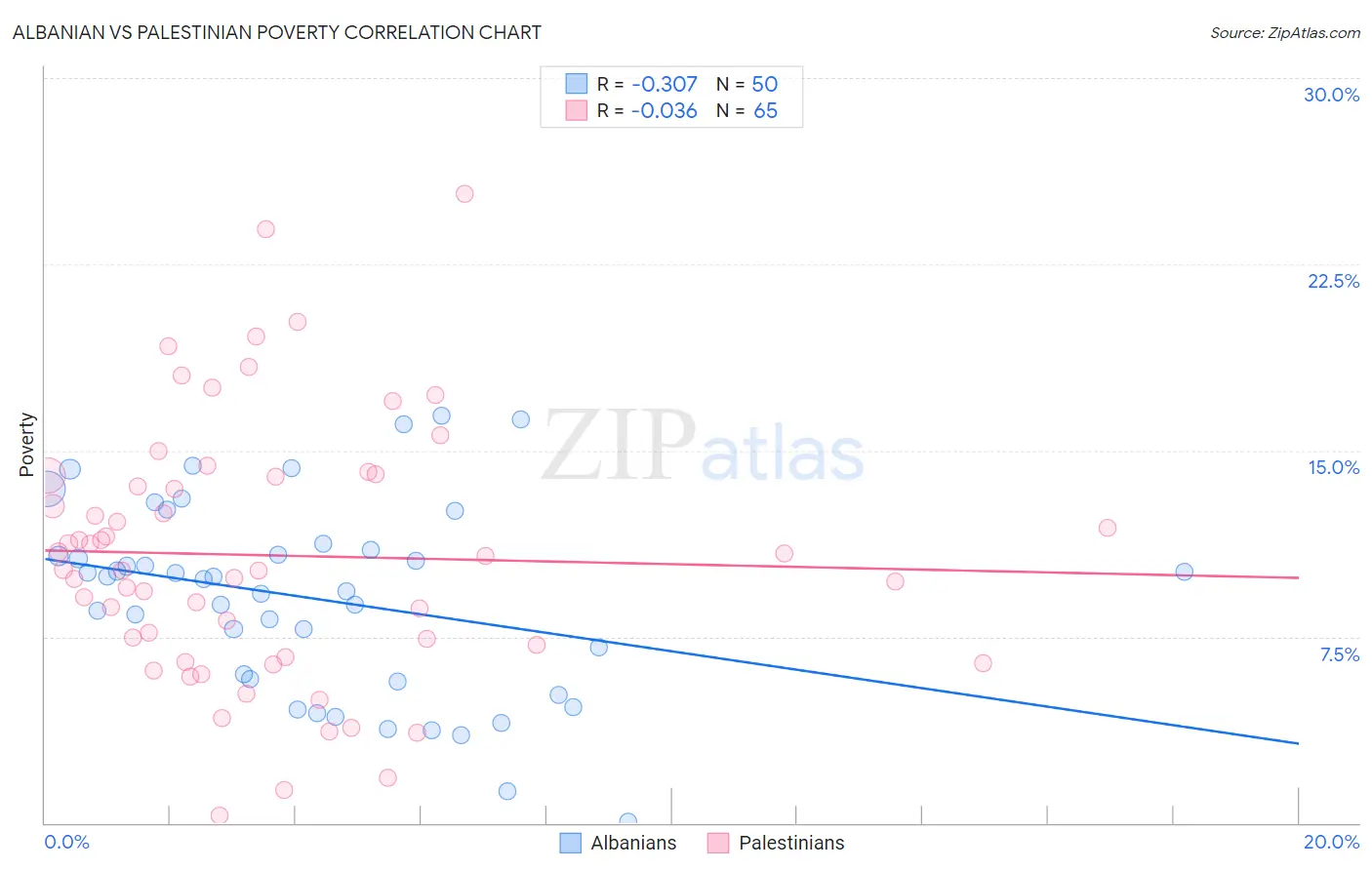Albanian vs Palestinian Poverty
COMPARE
Albanian
Palestinian
Poverty
Poverty Comparison
Albanians
Palestinians
11.7%
POVERTY
90.3/ 100
METRIC RATING
115th/ 347
METRIC RANK
11.6%
POVERTY
91.8/ 100
METRIC RATING
107th/ 347
METRIC RANK
Albanian vs Palestinian Poverty Correlation Chart
The statistical analysis conducted on geographies consisting of 193,180,317 people shows a mild negative correlation between the proportion of Albanians and poverty level in the United States with a correlation coefficient (R) of -0.307 and weighted average of 11.7%. Similarly, the statistical analysis conducted on geographies consisting of 216,388,270 people shows no correlation between the proportion of Palestinians and poverty level in the United States with a correlation coefficient (R) of -0.036 and weighted average of 11.6%, a difference of 0.49%.

Poverty Correlation Summary
| Measurement | Albanian | Palestinian |
| Minimum | 0.071% | 0.32% |
| Maximum | 16.4% | 25.3% |
| Range | 16.3% | 25.0% |
| Mean | 9.1% | 10.8% |
| Median | 9.9% | 10.2% |
| Interquartile 25% (IQ1) | 5.8% | 6.9% |
| Interquartile 75% (IQ3) | 11.0% | 14.0% |
| Interquartile Range (IQR) | 5.2% | 7.0% |
| Standard Deviation (Sample) | 3.9% | 5.2% |
| Standard Deviation (Population) | 3.8% | 5.2% |
Demographics Similar to Albanians and Palestinians by Poverty
In terms of poverty, the demographic groups most similar to Albanians are Immigrants from China (11.6%, a difference of 0.14%), Immigrants from Southern Europe (11.6%, a difference of 0.16%), Immigrants from Belarus (11.6%, a difference of 0.16%), Immigrants from Russia (11.7%, a difference of 0.17%), and French Canadian (11.6%, a difference of 0.23%). Similarly, the demographic groups most similar to Palestinians are Canadian (11.6%, a difference of 0.030%), Immigrants from Turkey (11.6%, a difference of 0.050%), Portuguese (11.6%, a difference of 0.090%), Immigrants from Zimbabwe (11.6%, a difference of 0.090%), and Welsh (11.6%, a difference of 0.090%).
| Demographics | Rating | Rank | Poverty |
| Slavs | 93.3 /100 | #101 | Exceptional 11.5% |
| Laotians | 92.4 /100 | #102 | Exceptional 11.6% |
| Okinawans | 92.4 /100 | #103 | Exceptional 11.6% |
| Native Hawaiians | 92.1 /100 | #104 | Exceptional 11.6% |
| Portuguese | 92.1 /100 | #105 | Exceptional 11.6% |
| Immigrants | Zimbabwe | 92.1 /100 | #106 | Exceptional 11.6% |
| Palestinians | 91.8 /100 | #107 | Exceptional 11.6% |
| Canadians | 91.7 /100 | #108 | Exceptional 11.6% |
| Immigrants | Turkey | 91.7 /100 | #109 | Exceptional 11.6% |
| Welsh | 91.6 /100 | #110 | Exceptional 11.6% |
| French Canadians | 91.0 /100 | #111 | Exceptional 11.6% |
| Immigrants | Southern Europe | 90.8 /100 | #112 | Exceptional 11.6% |
| Immigrants | Belarus | 90.8 /100 | #113 | Exceptional 11.6% |
| Immigrants | China | 90.7 /100 | #114 | Exceptional 11.6% |
| Albanians | 90.3 /100 | #115 | Exceptional 11.7% |
| Immigrants | Russia | 89.7 /100 | #116 | Excellent 11.7% |
| Sri Lankans | 89.4 /100 | #117 | Excellent 11.7% |
| Argentineans | 89.1 /100 | #118 | Excellent 11.7% |
| Tlingit-Haida | 89.0 /100 | #119 | Excellent 11.7% |
| Immigrants | South Eastern Asia | 88.9 /100 | #120 | Excellent 11.7% |
| New Zealanders | 88.7 /100 | #121 | Excellent 11.7% |